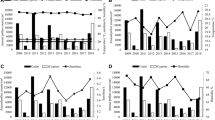Abstract
Japanese cedar (Cryptomeria japonica) pollinosis (JCP), affecting more than a quarter of the Japanese population, is a significant public health problem, due to its negative impact on daily activity. JCP patients have used the four-stage daily pollen deposition information based on the pollen monitoring over 20 years. However, the procedure for monitoring pollen was recently changed dramatically, to hourly average pollen concentration monitoring. In that type of monitoring, JCP patients cannot identify pollen exposure level because the relationship between hourly average pollen concentration and daily pollen deposition is unclear. Based on the parallel monitoring of concentration and deposition counts that we performed in Niigata prefecture, Eastern Japan, we found that the relationship between the daily pollen deposition (pollen cm−2 day−1) and the daily-average pollen concentration (pollen m−3) calculated from hourly average pollen concentration was not only statistically significant but also consistent with the aerodynamic properties of pollen. Using the relationship, we proposed new range criteria of hourly average pollen concentrations corresponding to the four stages of pollen deposition. Additionally, the conversion of pollen deposition to pollen concentration made the long-term trend analysis of the daily-average pollen concentration possible in this study area, and an increasing trend was identified at one site.






Similar content being viewed by others
References
Baba, K., & Nakae, K. (2008). National epidemiological survey of nasal allergy 2008 (compared with 1998) in otolaryngologists and their family members. Progress in Medicine, 28, 2001–2012. (in Japanese).
Draxler, R. R., & Hess, G. D. (1997). Description of the hysplit 4 modeling system. NOAA Technical Memorandum ERI. ARL-224. http://www.arl.noaa.gov/HYSPLIT_info.php.
Durham, O. C. (1946). The volumetric incidence of atmospheric allergens; A proposed standard method of gravity sampling, counting, and volumetric interpolation of results. Journal of Allergy, 17, 79–86.
Fujisaki, Y. (1985). Japanese cedar pollinosis–pollen count and pollinosis in Niigata city, Japan. Niigatashi ishikai hou, 175, 2–6. (in Japanese).
Fukaya, S. (2001). Development of real-time pollen counter. Arerugi no rinsyou, 273, 73–75. (in Japanese).
Gotoh, M., Okudo, K., & Okuda, M. (2005). Inhibitory effects of facemasks and eyeglasses on invasion of pollen particles in the nose and eye: A clinical study. Rhinology, 43, 266–270.
Hirose, Y., & Osada, K. (2016). Terminal setting velocity and physical properties of pollen grains in still air. Aerobiologia, 32, 385–394.
Imai, T., Nohara, O., Endo, T., & Fukaya, S. (2005). Usefulness and practical use of an automatic counter for scattering pollen in spring. Arerugi, 54, 559–568. (in Japanese).
JMA (Japan Meteorological Agency). (2017). Kako no kisyo data kensaku. http://www.data.jma.go.jp/obd/stats/etrn/index.php. Accessed May 16, 2017.
JMAFF (Japanese Ministry of Agriculture, Forestry and Fisheries). (2012). Sugi hinoki kafun ni kansuru jyoho. http://www.rinya.maff.go.jp/j/sin_riyou/kafun/index.html. Accessed August 16, 2016.
JME (Japanese Ministry of the Environment). (2016a). Kankyo sho kafun kansoku system. http://kafun.taiki.go.jp/Library.html. Accessed August 16, 2016.
JME (Japanese Ministry of the Environment). (2016b). Kankyo sho kafun kansoku system. http://kafun.taiki.go.jp/index.aspx?AreaCode=05&Time=2016053124. Accessed August 16, 2016.
JME (Japanese Ministry of the Environment). (2016c). Kankyo sho kafun kansoku system. http://kafun.taiki.go.jp/System.html. Accessed August 16, 2016.
Kmenta, M., Bastl, K., Jäger, S., & Berger, U. (2014). Development of personal pollen information—The next generation of pollen information and a step forward for hay fever suffers. International Journal of Biometeorology, 58, 1721–1726.
Mori, T., Yokoyama, M., Komiyama, N., Komiyama, N., Okano, M., & Kino, K. (1999). Purification, identification, and cDNA cloning of Cha o 2, the second major allergen of Japanese cypress pollen. Biochemical Biophysical Research Communications, 263, 166–171.
Okubo, K., Kurono, Y., Fujieda, S., Ogino, S., Uchio, E., Odajima, H., et al. (2014). Japanese guideline for allergic rhinitis 2014. Allergology International, 63, 357–375.
Pryor, S. C., Gallagher, M., Sievering, H., Larsen, S. E., Barthelmie, R. J., Birsan, F., et al. (2008). A review of measurement and modelling results of particle atmosphere-surface exchange. Tellus, 60B, 42–75.
Sahashi, N., Kishikawa, R., Nishima, S., & Nagano, H. (1993). Standardization of procedure for atmospheric pollen counts and pollen forecast in Japan. Japanese Journal Palynology, 39, 129–134. (in Japanese).
Saito, Y. (2014). Japanese cedar pollinosis: Discovery, nomenclature, and epidemiological trends. Proceedings of the Japan Academy Series B Physical and Biological Sciences, 90, 203–210.
Sasagawa, A., Watanabe, K., Aoyagi, M., Terao, M., Gotoh, K., & Abe, S. (1990). Studies on pollinosis. Annual report of Niigata prefectural research laboratory for health and environment, 6, 87–92. (in Japanese).
Seno, S., Enomoto, T., Dake, Y., Ikeda, H., Sakota, T., Saito, Y., et al. (2003). 2002 survey of airborne pollen in Wakayama city with a real-time pollen counter (KH-3000). Jibiinkoka Rinsyou, 96, 83–90. (in Japanese).
Takahashi, Y., Kawashima, S., Fujita, T., Ito, C., Mogami, K., & Ishimori, K. (2001). Comparison of the real-time pollen monitor (KH-3000) with Durham sampler. Peport of the Yamagata Prefectural Institute of Public Heatlh, 34, 29–32. (in Japanese).
Vallero, D. A. (2007). Fundamentals of air pollution (4th ed., p. 788). Cambridge: Academic Press.
Yamada, T., Saito, H., & Fujieda, S. (2014). Present state of Japanese cedar pollinosis: The national affliction. Journal of Allergy and Clinical Immunology, 133, 632–639.
Yamamoto, N., Matsuki, H., & Yanagisawa, Y. (2007). Application of the personal aeroallergen sampler to assess personal exposures to Japanese cedar and cypress pollens. Journal of Exposure Science & Environmental Epidemiology, 17, 637–643.
Yamamoto, N., Matuki, Y., Yokoyama, H., & Matsuki, H. (2015). Relationship among indoor, outdoor, and personal airborne Japanese cedar pollen counts. PLoS One, 10, 1–14. https://doi.org/10.1371/journal.pone.0131710.
Acknowledgements
The authors thank all Niigata prefecture government staff for their data collection and analysis on Japanese cedar pollinosis.
Author information
Authors and Affiliations
Corresponding author
Rights and permissions
About this article
Cite this article
Watanabe, K., Ohizumi, T. Comparability between Durham method and real-time monitoring for long-term observation of Japanese cedar (Cryptomeria japonica) and Japanese cypress (Cryptomeria obtusa) pollen counts in Niigata prefecture, Japan. Aerobiologia 34, 257–267 (2018). https://doi.org/10.1007/s10453-018-9511-0
Received:
Accepted:
Published:
Issue Date:
DOI: https://doi.org/10.1007/s10453-018-9511-0




